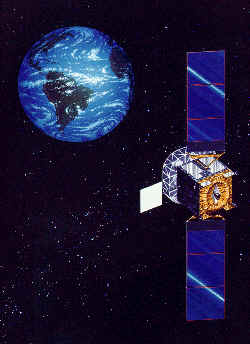Engineering:UFO (satellite)
This article includes a list of references, related reading or external links, but its sources remain unclear because it lacks inline citations. (January 2018) (Learn how and when to remove this template message) |
| This engineering needs to be updated. Please update this engineering to reflect recent events or newly available information. (January 2018) |
 Artist's impression of an UFO satellite | |
| Country of origin | United States |
|---|---|
| Operator | United States Air Force |
| Applications | Military communications |
| Specifications | |
| Bus | HS-601 |
| Design life | 14 years |
| Regime | Geosynchronous |
| Production | |
| Status | Active |
| Built | 0 |
| On order | 0 |
| Launched | 11 |
| Lost | 1 |
The Ultra High Frequency Follow-On (UFO) system is a United States Department of Defense (DOD) program sponsored and operated by the U.S. Navy to provide communications for airborne, ship, submarine and ground forces. The UFO constellation replaced the U.S. DOD Fleet Satellite Communications System (FLTSATCOM) constellation and will consist of eleven satellites. The ground terminal segment consists of equipment and resident personnel at existing satellite communication stations. The spacecraft are controlled by the Naval Satellite Operations Center (NAVSOC) located at the Naval Base Ventura County, Point Mugu, CA.
UHF Follow-On satellites
The UHF satellites will primarily serve tactical users. UFO provides almost twice as many channels as FLTSATCOM and has about 10 percent more power per channel. The EHF package on satellites four through eleven have an Earth coverage beam and a steerable five-degree spot beam that enhances its tactical use. The EHF capability also allows the UFO network to connect to the strategic Milstar system. Satellites eight, nine and ten also carry the Global Broadcast Service antennas that operate in the Ka-band.
First launch of the UFO took place on 25 March 1993, with constellation completion dependent on replacement needs for the aging FLTSATCOM constellation. The Atlas II is the current launch vehicle of choice; however, space shuttle compatibility existed. The UFO bus and payload weigh 2,300 pounds (1.04 tonne). The solar array spans 60.5 feet (18.4 m) and produce 2,500 watts at the end of the planned 14-year lifetime.
The UHF system supports stationary and mobile users including manportable, ships, submarines, aircraft and other mobile terminals. The UFO Follow-on system is schedule for replacement by the Mobile User Objective System (MUOS).
References
- Federation of American Scientists: UFO System
- Boeing: UFO System
- GlobalSecurity.org: UFO System
- GlobalSecurity.org: MUOS

